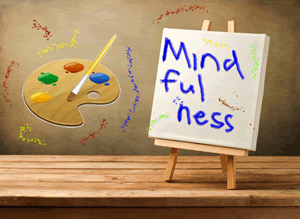 A wide, wonderful window of opportunity exists to engage children with positive Mindful possibilities. Creative opportunities for children, of all ages, to nurture the ability to cultivate conscious, compassionate awareness.
A wide, wonderful window of opportunity exists to engage children with positive Mindful possibilities. Creative opportunities for children, of all ages, to nurture the ability to cultivate conscious, compassionate awareness.
Drawing on the key character strength of curiosity, an inquiry- based approach enables each child to ‘join their own dots’ and make personal discoveries.
Often learning has an external focus. Yet there is so much to learn and discover about our inner world. Mindful meditation addresses this imbalance. Children can begin to deeply appreciate and begin to feel custodians of the magnificent inner resource of their bodies and minds.
In the excellent book ‘Educating from the Heart: Theoretical and Practical Approaches to Transforming Education’ Paul Houston says that education is about making connections and that if we can connect to the hearts of children: ‘you will bring their heads along’. He also says ‘We are the keepers of children’s possibilities’.
As ‘keepers of children’s possibilities’ we are privileged. Despite working in this field for over 15 years with over 75 schools, every class feels like a fresh, new beginning to explore creative Mindful experiences with children.
Any living organism that is not connected to sources of energy will not prosper. The life skill of inner connectedness is vital for children to thrive. Mindfulness helps children develop a personal ‘root system’: a strong, stable foundation, drawing on awareness of physical, emotional, mental and spiritual sources of energy.
We know that physical health does not come about by chance. Physical wellbeing is the result of diet, exercise, hydration, rest and healthy relationships. Positive mental health exists in a symbiosis with physical health and is usually not the result of luck either.
Mindful Meditation provides a wonderful way to help children of all ages establish a robust personal foundation. Children can have fun as they cultivate awareness and discover how to effectively focus their attention: the pre-requisite for learning. By choosing where their attention goes and sustaining attention, they can literally change their minds … and make up their minds! Studies in neuroplasticity reveal that the brain is able to change its own structure, responding positively to stimulus, exercise and challenges.
It is a joy to work with primary aged children. The five basic senses provide a creative palette of entry points. Oliver Sacks has identified the sense of proprioception, the ‘sixth sense’, as: ‘arguably more vital than any or all of the other five senses put together’ (‘On the Move: A Life’ Oliver Sacks). A wide range of Mindful movements enhance proprioception, including yoga, qi gong, tai chi, Feldenkrais and Nia. Sitting and stillness practices are an important part of the Mindfulness palette, but a holistic approach ensures connection to all learning styles. It is important to make sense of mindfulness and literally bring skills to life, so that children can apply them on a daily basis in all aspects of their lives.
Heart/Mind/Hands-on experiences enliven and energize classrooms. All kinds of fun-filled opportunities; teaching aids, games, music, stories and activities provide a rich palette to infuse lessons with ways to captivate attention and fire neurons! Simple props, such as the ‘Speaking Stick’ effortlessly bring about active listening skills, develop patience and the ability to take turns.
Discussions related to themes and concepts engender mutual respect and empathy. My experience has been that over time these sessions deepen bonds between students and teachers. This culminates in harmonious, co-operative classrooms.
Age appropriate themes and teaching aids help secondary students to find relevance and purpose in Mindful practices. The ‘window of opportunity’ is opened at this age to introduce more sophisticated themes and concepts. Fertile opportunities exist between Mindfulness and the tenets of Positive Education to explore and expand concepts. Awareness is the cornerstone of these skills. Character Strengths, Mindsets, Resilience and many other key skills can be effectively bought to life and consolidated with Mindful practices.
With the challenges and constraints of the crowded curriculum, all kinds of simple practices can contribute ‘Mindful punctuation’ into the school day: providing ‘bookends’, transition points and opportunities to refresh and renew focus and concentration. Opportunities exist to apply Mindfulness in every facet of school life: tailored approaches to suit each subject, school assemblies, on the sport field and even in the sick bay!
Many schools are now committing to comprehensive Mindfulness programs. Often administration and other staff are welcomed to Professional Development training. Information sessions are also scheduled for parents. This brings a wonderful opportunity to build a strong, embedded Mindful school culture.
Our life is literally the creation of our mind. Mindful practices empower children to make kind, positive choices for themselves and the world. A rich palette of creative, engaging and joyful Mindful possibilities can be drawn upon to support children to be the keepers of their own beautiful minds.
Janet Etty-Leal
www.meditationcapsules.com


